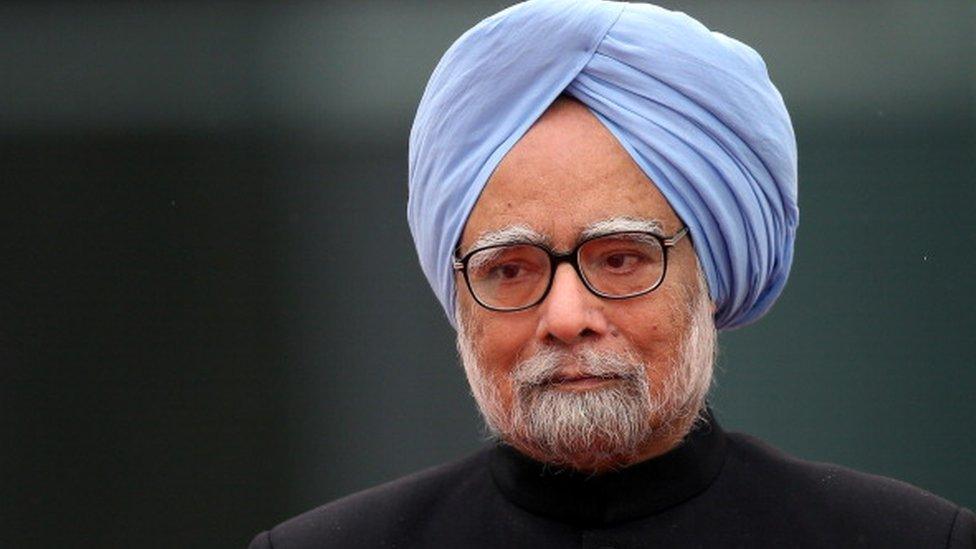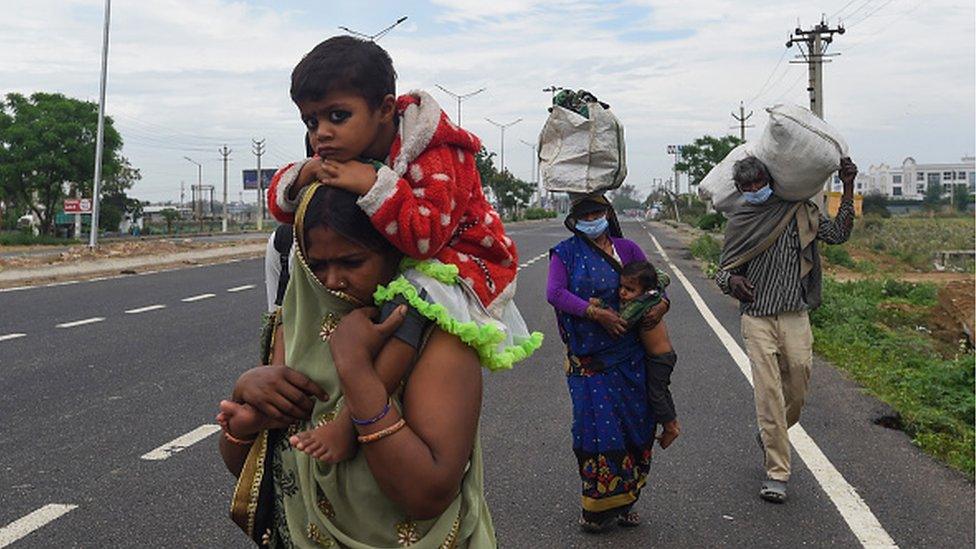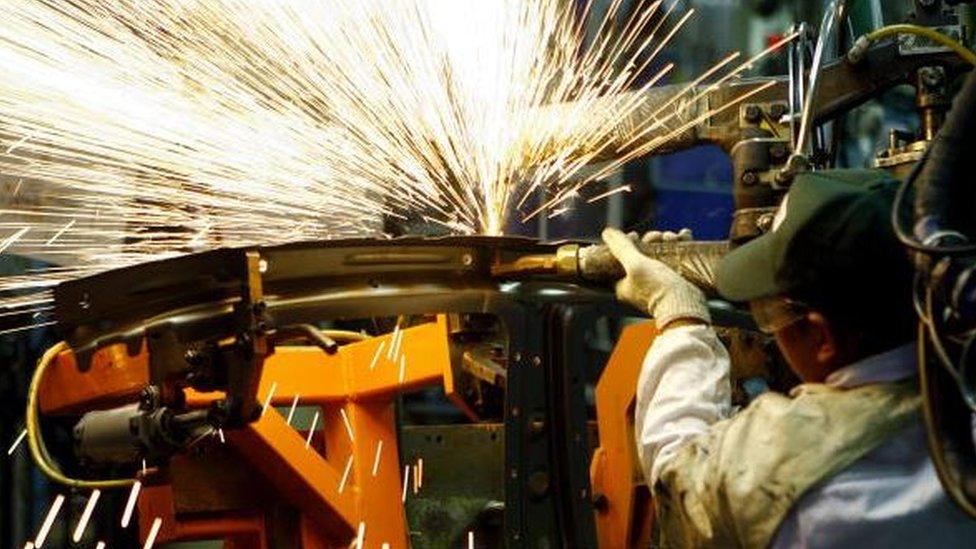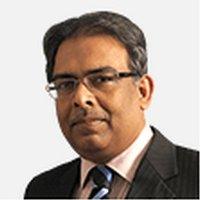Manmohan Singh's 'three steps' to stem India's economic crisis
- Published

Manmohan Singh is widely regarded as the architect of India's economic reforms programme
India must take three steps "immediately" to stem the damage of the coronavirus pandemic, according to its former prime minister Manmohan Singh.
Dr Singh, who is widely regarded as the architect of India's economic reforms programme, and is now a senior leader of the main opposition Congress party, spoke to BBC this week in an email exchange. The coronavirus pandemic ruled out a face-to-face interview and Dr Singh declined a video call.
During our exchange, he laid out three steps he believes the government has to take to stem the crisis and restore economic normalcy in the coming years.
First, the government should "ensure people's livelihoods are protected and they have spending power through a significant direct cash assistance".
Second, it should make adequate capital available for businesses through "government-backed credit guarantee programmes".
Third, it should fix the financial sector through "institutional autonomy and processes".
India's economy was already in the throes of a slowdown before the beginning of the pandemic - GDP grew at 4.2% in the 2019-20, its slowest pace in nearly a decade. The country is now gradually unlocking its economy after a prolonged and grinding shutdown, but the future looks uncertain as infection numbers rise. On Thursday, India became the third country to pass two million Covid-19 cases.
Economists have since warned that India's GDP for the 2020-21 financial year is likely to contract sharply, leading to the worst technical recession since the 1970s.

Millions of migrant workers and the poor lost their livelihoods during the lockdown
"I do not want to use words like 'depression' in a cavalier fashion," Dr Singh said, but a "deep and prolonged economic slowdown" was "inevitable".
"This economic slowdown is caused by a humanitarian crisis. It is important to view this from the prism of sentiments in our society than mere economic numbers and methods," he said.
Dr Singh pointed to a consensus forming among economists over an economic contraction in India in nominal terms, "which if it happens, will be the first time in independent India".
"I hope the consensus is wrong," he said.
India locked down early, at the end of March, to prevent the spread of the coronavirus. Many believe the lockdown was hastily executed and did not anticipate the exodus of millions of out-of-work migrant workers from cities.
Dr Singh believes India did what other nations were doing, and "perhaps a lockdown at that stage was an inevitable choice".
"But the government's shock and awe approach to the lockdown has caused tremendous pain to people. The suddenness of the announcement and the stringency of the lockdown were thoughtless and insensitive," he said.
"Public health emergencies such as this are best dealt with locally by local administrators and public health officials, with broad guidelines from the Centre. Perhaps, we should have devolved the Covid-19 battle to the state and local administrations much sooner."

Private sector investment is at a 15-year low
As finance minister, 29 years ago, Dr Singh helmed an ambitious economic reform programme in 1991 after a balance of payments crisis nearly plunged India into bankruptcy.
The 1991 crisis was a domestic crisis induced by global factors, he said. "But today's economic situation is unprecedented in its ubiquity, scale and depth."
Not even during World War Two had the "whole world shut down in such a synchronised fashion as it is now", he said.
In April Narendra Modi's BJP-led government announced a $266bn (£212bn) stimulus, including a range of liquidity measures and reforms to kickstart the economy. India's central bank also introduced rate cuts and moratoriums on loans.
With tax receipts plummeting, economists have debated about how a cash-strapped government would be able to get the money to fund direct transfers and provide more capital to ailing banks and credit to businesses.
The answer, said Dr Singh was borrowing.
"Higher borrowing is inevitable," he said. "Even if we have to spend an additional 10% of the Gross Domestic Product (GDP) to cater to the military, health and economic challenges, it must be done.
He acknowledged that it would increase India's debt to GDP ratio, but if borrowing "can save lives, borders, restore livelihoods and boost economic growth, then its worth it", he said.
"We must not be shy of borrowing but we must be prudent on how we use that borrowing," he said.

India needs to produce more for its domestic market
In the past, taking loans from multilateral institutions like the IMF and World Bank have been taken as signs of India's economic weaknesses. But now India could "borrow from a position of strength, compared to other developing nations," Dr Singh said.
"India's track record as a borrower from multilateral institutions is impeccable, It is not a sign of weakness to borrow from these institutions."
Many countries have decided to print money to fund government spending to tide over the ongoing economic crises, and some prominent economists have suggested the same for India. Others have raised fears about excess supply of money leading to inflation.
Monetisation of the fiscal deficit directly by India's central bank used to be norm until the mid 1990s. India, Dr Singh said, had moved away from the practice to bring about "fiscal discipline, institutional separation from the Reserve Bank of India [central bank] and the government and to curb unhealthy impulses of seemingly free money".
"I am aware that the traditional fear of high inflation due to excess money supply is perhaps no longer valid in developed nations," he said. "But for countries such as India, other than costs of institutional autonomy of the central bank, unbridled printing of money can have attendant impacts on currency, trade and imported inflation."
Dr Singh said he was not ruling out printing money to finance the deficit, but "merely suggesting that let the barrier for that to be very high and use it as a last resort when all other options have been exhausted".
He warned against India following some other nations in becoming more protectionist - imposing high trade barriers duties on imports. India's trade policy over the last three decades had brought "enormous economic gains to not just the top but across all sections of our population", he said.

India's rising upper middle class has substantial disposable income
As Asia's third largest economy, India today is in a far stronger position today than in the early 1990s. I asked Dr Singh whether these strengths would help India stage a robust recovery after the pandemic ends.
"India's real GDP is 10 times stronger than what it was in 1990, and India had lifted more than 300 million people from poverty since then," he said. "So yes, the Indian economy is intrinsically much stronger now."
But a significant driver of that growth was India's trade with the rest of the world. The share of global trade in India's GDP increased nearly fivefold in this period.
"India is much more integrated with the rest of the world now," Dr Singh said. "Hence, what happens in the global economy will have a significant impact on India's economy. In this pandemic, the global economy is severely dented and that will be a big cause of concern for India."
Ultimately, no one yet knows the full economic impact of the coronavirus pandemic, nor how long nations will take to recover from it. But one thing is clear, it has defied the experience of even seasoned economists like Dr Singh.
"The previous crises were macroeconomic crises for which there were proven economic tools," he said. "Now we have an economic crisis caused by an epidemic which has induced fear and uncertainty in society, and monetary policy as an economic tool to counter this crisis is proving to be blunt."
- Published24 April 2020

- Published3 April 2020

